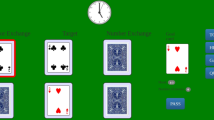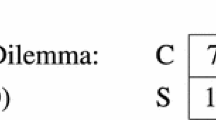Abstract
According to Epstein (1985), extinction is one of the main processes for creative problem solving. To test this assertion, we present an experiment in which we manipulated extinction in a problem situation using the computer game Portal 2®. Three groups of participants were exposed to the same problem (i.e., get out of a chamber) under two different conditions. Two groups of participants learned the prerequisite behavior to solve the problem (NOEXT and EXT), but one group did not receive this training (BL). Under one condition, the problem could be solved in two ways: either by emitting a new flexible behavior (innovative) or by doing all of the previously learned behaviors (not innovative). Under the second condition, the problem had to be solved by emitting the innovative behavior, and the learned behaviors were under operational extinction. NOEXT was exposed to the first condition and EXT and LB groups to the second. Results showed that all participants from EXT and NOEXT, but fewer than half of LB groups, solved the problem, corroborating previous data that showed that creative problem solving is a function of previous learning. All but two participants from the NOEXT group solved the problem by emitting the learned behaviors; thus, extinction increased the likelihood of emitting new and flexible problem-solving behaviors. The results also showed that the EXT group spent more time solving the problem, emitted a higher frequency of behaviors other than E1, and interacted more often with objects than the NOEXT group. Therefore, even if the problem-solving behavior of EXT and NOEXT groups was equally effective for obtaining the solution, it was not equally efficient. We discuss that the constraints (i.e., extinction vs. no extinction) of each problem imposed different learning conditions during problem solving. New learning was necessary to produce the new and flexible problem solving of the EXT group, and this process demands more time and effort than solving the problem by just performing what was learned in the past, as the NOEXT group did. Finally, results also suggested a modulatory effect of gaming experience of the effects of experimental training on creative problem solving, because the participants from LB who solved the problem were those with more experience with different types of games.







Similar content being viewed by others
Data availability
The data that support the findings of this study are available from the corresponding author upon reasonable request.
Notes
See https://developer.valvesoftware.com/wiki/Portal_2_Puzzle_Maker/Getting_Started for a complete list of the objects and other entities.
BL participants did not receive training of the prerequisite behaviors (i.e., they did not acquire the behaviors that were under operational extinction during the problem situation).
References
Ansburg, P. I., & Dominowski, R. L. (2000). Promoting insightful problem-solving. Journal of creative behavior, 34, 30–60. https://doi.org/10.1002/j.2162-6057.2000.tb01201.x.
Baron, R. M., & Kenny, D. A. (1986). The moderator-mediator variable distinction in social psychological research: Conceptual, strategic, and statistical considerations. Journal of Personality & Social Psychology, 51(6), 1173. https://doi.org/10.1037//0022-3514.51.6.1173.
Blaisdell, A. P., Stolyarova, A., & Stahlman, W. D. (2016). The law of expect or a modified law of effect? Conductual, 4(2). https://www.semanticscholar.org/paper/The-Law-of-Expect-or-a-Modified-Law-of-Effect-Blaisdell-Stolyarova/bf9ff34c932a09721fa55499f8285f97e00e20f9
Birch, H. G. (1945). The relation of previous experience to insightful problem-solving. Journal of Comparative Psychology, 38(6), 367. https://doi.org/10.1037/h0056104.
Cook, R. G., & Fowler, C. (2014). “Insight” in pigeons: Absence of means-end processing in displacement tests. Animal Cognition, 17(2), 207–220. https://doi.org/10.1007/s10071-013-0653-8.
Csikszentmihalyi, M. (2014). The systems model of creativity. Springer.
Cziko, G. A. (1998). From blind to creative: In defense of Donald Campbell's selectionist theory of human creativity. Journal of Creative Behavior, 32(3), 192–209. https://doi.org/10.1002/j.2162-6057.1998.tb00815.x.
Davidson, J. E. (2003). Insights about insightful problem-solving. In J. E. Davidson & R. J. Sternberg (Eds.), The psychology of problem-solving (pp. 149–175). Cambridge University Press. https://doi.org/10.1017/CBO9780511615771.006.
Dunbar, K. (1998). Problem-solving. In W. Bechtel & G. Graham (Eds.), A companion to cognitive science (pp. 289–298). Blackwell.
Epstein, R. (1983). Resurgence of previously reinforced behavior during extinction. Behaviour Analysis Letters, 3(6), 391–397. https://www.researchgate.net/publication/267720778_Resurgence_of_Previously_Reinforced_Behavior_During_Extinction
Epstein, R. (1985a). The spontaneous interconnection of three repertoires. The Psychological Record, 35(2), 131–141. https://doi.org/10.1007/BF03394917.
Epstein, R. (1985b). Animal cognition as the praxist views it. Neuroscience & Biobehavioral Reviews, 9(4), 623–630. https://doi.org/10.1016/0149-7634(85)90009-0.
Epstein, R. (1987). The spontaneous interconnection of four repertoires of behavior in a pigeon (Columba livia). Journal of Comparative Psychology, 101(2), 197.
Epstein, R. (1990). Generativity theory and creativity. In M. A. Runco & R. S. Ablert (Eds.), Theories of creativity (pp. 116-140). Newbury Park, CA: Sage.
Epstein, R. (1991). Skinner, creativity, and the problem of spontaneous behavior. Psychological Science, 2(6), 362–370 http://www.jstor.org/stable/40062712.
Epstein, R. (1999). Generativity theory. In M. A. Runco (Ed.), Encyclopedia of Creativity (pp. 759–766). Elsevier Academic Press.
Epstein, R. (2015). Of course animals are creative: Insights from generativity theory. In Animal creativity and innovation (pp. 375-393). Academic Press.
Epstein, R., Kirshnit, C. E., Lanza, R. P., & Rubins, L. C. (1984). “Insight” in the pigeon: Antecedents and determinants of an intelligent performance. Nature, 308, 61–62. https://doi.org/10.1038/308061a0.
Harlow, H. F. (1949). The formation of learning sets. Psychological Review, 56(1), 51 https://psycnet.apa.org/doi/10.1037/h0062474.
Hebb, D. O. (1947). The effects of early experience on problem-solving at maturity. American Psychologist, 2, 306–307.
Holt, G. L. (1975). Correction procedures in extinction of matching behavior. Bulletin of the Psychonomic Society, 5(3), 209–212. https://doi.org/10.3758/BF03337605.
Kolari, S., Savander-Ranne, C., & Viskari, E. L. (2008). Learning needs time and effort: A time-use study of engineering students. European Journal of Engineering Education, 33(5–6), 483–498. https://doi.org/10.1080/03043790802564046.
Lattal, K. A., Peter, C., & Escobar, R. (2013). Operant extinction: Elimination and generation of behavior. In G. J. Madden (Ed.), APA handbook of behavior analysis: Vol. 2. Translating principles into practice (pp. 77- 107). American Psychological Association.
Luciano, C. (1991). Problem-solving behavior: an experimental example. Psicothema, 3(2), 297–317 http://www.psicothema.com/psicothema.asp?id=2022.
Maier, N. R. (1931). The solution of a problem and its appearance in consciousness. Journal of Comparative Psychology, 12(2), 181 https://philpapers.org/go.pl?id=MAIRIH-3&proxyId=&u=http%3A%2F%2Fdx.doi.org%2F10.1037%2Fh0071361.
Miller, R. R., & Matzel, L. D. (2014). Contingency and relative associative strength. In S. B. Klein & R. R. Mowrer (Eds.), Contemporary learning theories: Vol. II: Instrumental conditioning theory and the impact of biological constraints on learning (p. 61-84), Psychology Press.
Neves Filho, H. B., Stella, L. D. R., Dicezare, R. H. F., & Garcia-Mijares, M. (2015). Insight in the white rat: spontaneous interconnection of two repertoires in Rattus norvegicus. European Journal of Behavior Analysis, 16(2), 188-201. https://doi.org/10.1080/15021149.2015.1083283
Neves Filho, H. B., de Carvalho Neto, M. B., Taytelbaum, G. P. T., dos Santos Malheiros, R., & Knaus, Y. C. (2016). Effects of different training histories upon manufacturing a tool to solve a problem: Insight in capuchin monkeys (Sapajus spp.). Animal Cognition, 19(6), 1151–1164. https://doi.org/10.1007/s10071-016-1022-1.
Neves Filho, H. B., Knaus, Y. C., & Taylor, A. H. (2019). New Caledonian crows can interconnect behaviors learned in different contexts, with different consequences and after exposure to failure. International Journal of Comparative Psychology, 32. https://escholarship.org/uc/item/85b0q1r9#main
Neves Filho, H. B., Assaz, D. A., Dicezare, R. H. F., Knaus, Y. C., & Garcia-Mijares, M. (2020). Learning behavioral repertoires with different consequences hinders the interconnection of these repertoires in pigeons in the box displacement test. The Psychological Record, 1–9. https://doi.org/10.1007/s40732-020-00407-0
Neuringer, A. (2003). Creativity and reinforced variability. In K. A. Lattal & P. N. Chase (Eds.), Behavior theory and philosophy (pp. 323–338). New York: Klewer Academic/Plenum Publishers. https://doi.org/10.1007/978-1-4757-4590-0_17.
Neuringer, A. (2004). Reinforced variability in animals and people: Implications for adaptive action. American Psychologist, 59(9), 891. https://doi.org/10.1037/0003-066X.59.9.891.
Neuringer, A., Kornell, N., & Olufs, M. (2001). Stability and variability in extinction. Journal of Experimental Psychology: Animal Behavior Processes, 27(1), 79–94. https://doi.org/10.1037/0097-7403.27.1.79.
Pryor, K. W., Haag, R., & O'Reilly, J. (1969). The creative porpoise: Training for novel behavior 1. Journal of the Experimental Analysis of Behavior, 12(4), 653–661. https://doi.org/10.1901/jeab.1969.12-653
Santana, L. H., & Garcia-Mijares, M. (2021). Animal Creativity as a Function of Behavioral Innovation and Behavior Flexibility in Problem-solving Situations. Integrative Psychological and Behavioral Science, 1-16. https://doi.org/10.1007/s12124-020-09586-5.
Shettleworth, S. J. (2012). Do animals have insight, and what is insight anyway? Canadian Journal of Experimental Psychology/Revue canadienne de psychologie expérimentale, 66(4), 217. https://doi.org/10.1037/a0030674.
Skinner, B. F. (1984). An operant analysis of problem-solving. Behavioral & Brain Sciences, 7(4), 583–591. https://doi.org/10.1017/S0140525X00027412.
Simonton, D. K. (2011). Creativity and discovery as blind variation and selective retention: Multiple-variant definition and blind-sighted integration. Psychology of Aesthetics, Creativity, & the Arts, 5(3), 222–228. https://doi.org/10.1037/a0023144.
Stokes, P. D. (1995). Learned variability. Animal Learning & Behavior, 23(2), 164–176. https://doi.org/10.3758/BF03199931.
Stokes, P. D. (2014). Crossing disciplines: A constraint-based model of the creative/innovative process. Journal of Product Innovation Management, 31(2), 247–258. https://doi.org/10.1111/jpim.12093.
Sturz, B. R., Bodily, K. D., & Katz, J. S. (2009). Dissociation of past and present experience in problem-solving using a virtual environment. Cyberpsychology & Behavior, 15(1), 15–19. https://doi.org/10.1089/cpb.2008.0147.
Conflict of Interest
The authors declare that they have no conflict of interest.
Ethics Approval
The procedures used in this study were approved by the Human Research Ethics Committee from the Institute of Psychology of the University of São Paulo and by the National Research Ethics Committee. Also, the procedures used in this study adhere to the tenets of the Declaration of Helsinki.
Consent to participate
Informed consent was obtained from all individual participants included in the study.
Consent to publish
Human research participants signed informed consent regarding publishing their data.
Funding
This study was funded by FAPESP (Fundação de Amparo à Pesquisa do Estado de São Paulo)—Grants 2018/04824-1 and 2019/27401-1.
Author information
Authors and Affiliations
Corresponding author
Additional information
Publisher’s Note
Springer Nature remains neutral with regard to jurisdictional claims in published maps and institutional affiliations.
Appendices
Appendix 1
Previous Game Experience Questionnaire

Appendix 2
Training and Test chambers
Appendix 3
Appendix 4
Results from Basic Commands and Training Phases
Rights and permissions
About this article
Cite this article
Rodrigues, R.S., Garcia-Mijares, M. To Fail or Not to Fail? Implications of Extinction on Creativity and Problem-Solving Behavior. Psychol Rec 71, 525–542 (2021). https://doi.org/10.1007/s40732-021-00482-x
Accepted:
Published:
Issue Date:
DOI: https://doi.org/10.1007/s40732-021-00482-x










